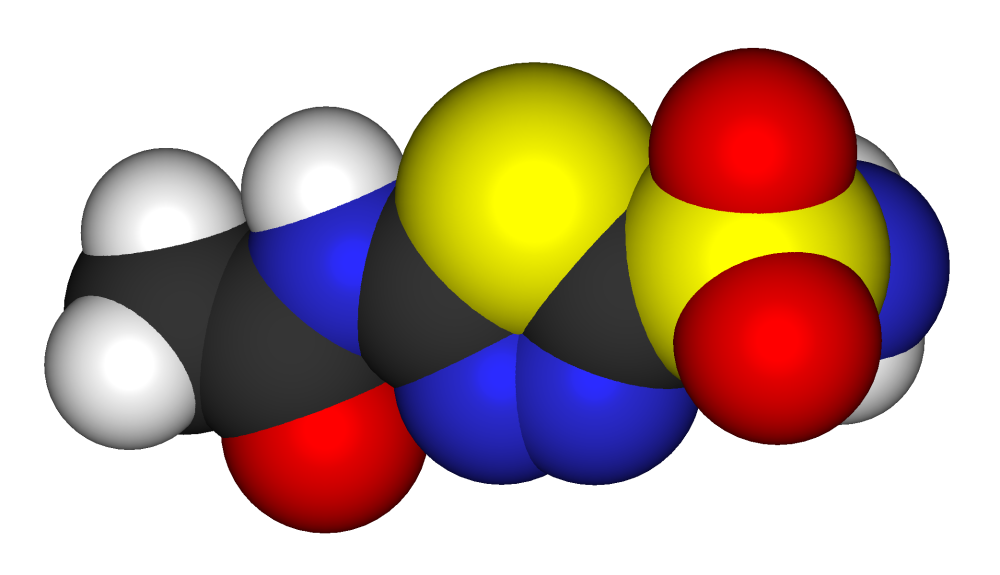Acetazolamide (extended-release capsule)
| Error creating thumbnail: File missing | |
 | |
| Clinical data | |
|---|---|
| Pregnancy category | |
| Routes of administration | Oral, IV |
| ATC code | |
| Legal status | |
| Legal status | |
| Pharmacokinetic data | |
| Metabolism | None |
| Elimination half-life | 3 to 9 hours |
| Excretion | Renal |
| Identifiers | |
| |
| CAS Number | |
| PubChem CID | |
| DrugBank | |
| E number | {{#property:P628}} |
| ECHA InfoCard | {{#property:P2566}}Lua error in Module:EditAtWikidata at line 36: attempt to index field 'wikibase' (a nil value). |
| Chemical and physical data | |
| Formula | C4H6N4O3S2 |
| Molar mass | 222.248 g/mol |
Please Take Over This Page and Apply to be Editor-In-Chief for this topic: There can be one or more than one Editor-In-Chief. You may also apply to be an Associate Editor-In-Chief of one of the subtopics below. Please mail us [1] to indicate your interest in serving either as an Editor-In-Chief of the entire topic or as an Associate Editor-In-Chief for a subtopic. Please be sure to attach your CV and or biographical sketch.
Overview
Acetazolamide, sold under the trade name Diamox, is a carbonic anhydrase inhibitor that is used to treat glaucoma, epileptic seizures, benign intracranial hypertension, altitude sickness, cystinuria, and dural ectasia. Acetazolamide is available as a generic drug and is also used as a diuretic.
Uses
General
Acetazolamide is often used in the treatment of various diseases. For glaucoma sufferers, the drug decreases fluid formation in the eye resulting in lower intraocular pressure. In epilepsy, its main use is in absence seizures, with some benefit in other seizure syndromes. It is also used to decrease generation of cerebrospinal fluid in benign intracranial hypertension and has also shown efficacy in autosomal dominant hyperkalemic periodic paralysis. It has also been demonstrated in drug trials to relieve symptoms associated with dural ectasia in indivduals with Marfan Syndrome.
Acute mountain sickness
Acetazolamide is best taken prophylactically, anywhere between 125 milligrams (mg) to 500 mg per day, starting a few days before going to the higher altitude. The drug forces the kidneys to excrete bicarbonate, the conjugate base of carbonic acid. By increasing the amount of bicarbonate excreted in the urine, the blood becomes more acidic. Acidifying the blood stimulates ventilation, which is beneficial during acclimatization. Others only take it when symptoms begin to appear so they can tell whether the drug really has any benefits for them. Whereas some people have reported that it relieves mild cases of acute mountain sickness, it is best taken prophylactically.
Note that acetazolamide is not an immediate fix for acute mountain sickness; it speeds up acclimatization which in turn helps to relieve symptoms. This may take up to a day or two, and requires waiting without any further rapid ascent. It is often advisable to descend if even mild acute mountain sickness is experienced. If serious sickness is encountered, descent is considered mandatory unless other circumstances present greater danger.
Side-effects
Common side effects of using this drug include numbness and tingling in the fingers and toes, and taste alterations (parageusia), especially for carbonated drinks; both are usually due to mild hypokalemia (low potassium levels). Some may also experience blurred vision but this usually disappears shortly after stopping the medication. Acetazolamide also increases the risk of developing calcium oxalate and calcium phosphate kidney stones. Everyone will experience more frequent urination as a result of using acetazolamide. One should drink more fluids than usual to prevent dehydration and headaches. Acetazolamide prolongs the effects of amphetamines and related drugs.
Contraindications
Acetazolamide should not be taken by individuals if:
- They have sickle cell anemia
- They are allergic to sulfa medications
- They are allergic to any carbonic anhydrase inhibitor
- They have liver or kidney disease
- They have adrenal gland failure (i.e. Addison's disease)
- They have diabetes
- They are pregnant or nursing mothers
Myths
- 'Acetazolamide covers up symptoms.' Not so: Acetazolamide speeds up acclimatization which in turn helps to alleviate symptoms. However, if you still feel sick, you need to stop ascending immediately.
- 'Acetazolamide prevents acute mountain sickness from getting worse.' Not so: If your symptoms are not improving, continued ascent can lead to HAPE or HACE.
- 'Stopping the drug causes symptoms to worsen.' Not so: Your body will just return to its own acclimatization rate. If you are already acclimatized, the drug will not change that fact.
References
- Going Higher: Oxygen Man and Mountains by Charles Houston, M.D., Fifth Edition, 2005. ISBN 0-89886-631-6.
- Complete Guide to Prescription & Non-Prescription Drugs by H. Winter Griffen, M.D., Sixth edition, 1989. ISBN 0-89586-754-0.
- http://www.ismmed.org/np_altitude_tutorial.htm
- Dural Ectasia in the Marfan Spine: Symptoms and Treatment. November 27, 2006. http://www.spineuniverse.com/displayarticle.php/article922.html
- Diamox - Quoted from the Physician's Desk Reference 1993 http://www.climber.org/gear/diamox.html
Template:SIB Template:Anticonvulsants Template:Antiglaucoma preparations and miotics
- Pages with script errors
- E number from Wikidata
- ECHA InfoCard ID from Wikidata
- Chemical articles with unknown parameter in Infobox drug
- Articles without EBI source
- Chemical pages without ChemSpiderID
- Articles without KEGG source
- Articles without InChI source
- Articles without UNII source
- Articles containing unverified chemical infoboxes
- Carbonic anhydrase inhibitors
- Mountaineering
- Anticonvulsants
- Sulfonamides